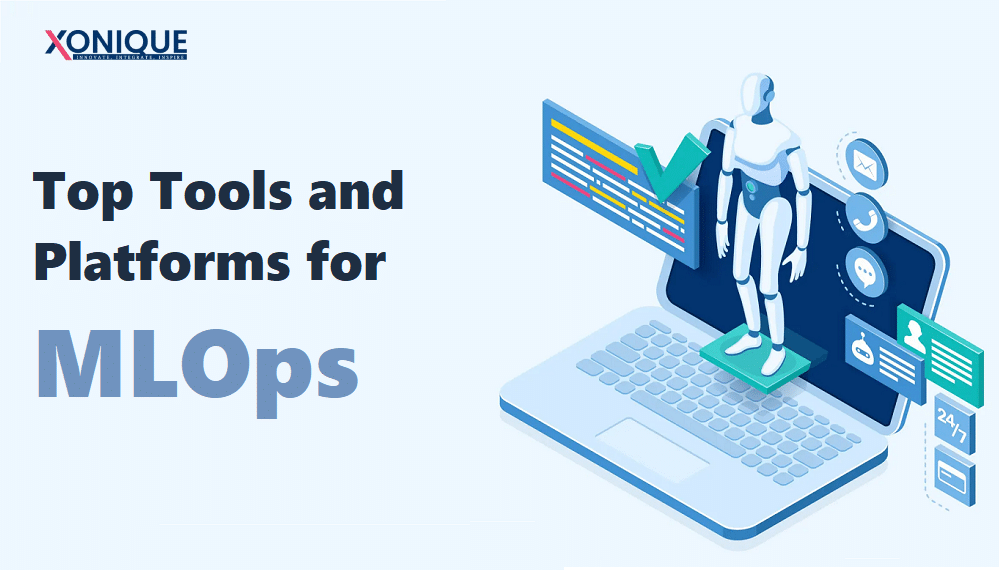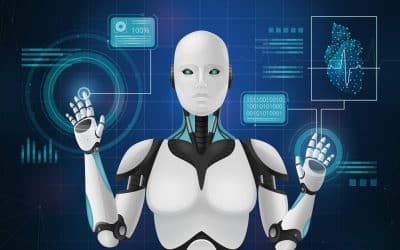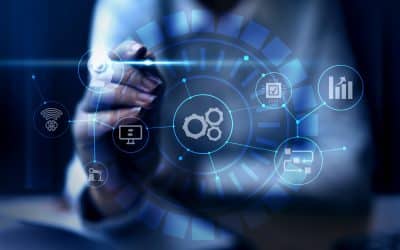Many people associate ‘machine learning’ with a large canvas covered in mathematical and statistical formulae that are challenging to understand. Data science is a complex field to enter because it involves a lot of complex algorithms. It is high time that you explore this new sphere of MLOps.
Machine learning (ML) is being incorporated into the operations of almost every company. A recent Refinitiv AI/ML study found that 46% of companies had fully implemented machine learning into their business operations. 44% used it only partially.
Machine learning has become popular because it allows enterprises to perform tasks at a previously impossible scale. MLOps is a new engineering discipline based on DevOps that aims to build ML systems capable of solving the machine learning development challenges associated with managing the Software Development Lifecycle (SDLC).
AI and ML leaders have a much better understanding of MLOps and the technology and procedures required to deploy new models in production (and then scale them). McKinsey’s State of AI 2022 Report notes that standard tool frameworks and development processes separate AI high-performers from others.
What is MLOps?
The goal of technology is to automate tasks and minimize human effort with the ultimate goal of improving performance. This new discipline, MLOps, automates various tasks when deploying a machine-learning project. MLOps is a set of practices that data scientists and engineers follow to speed up the deployment of machine learning models in real-world projects.
Take a look at the steps.
Metadata Management and Storage
Create Checkpoints on the Pipeline
Tuning Hyperparameters
Run workflow pipelines, orchestration, and automation
Deploying models and serving
Monitor the models in production
MLOps is a set of tools that can help you improve your speed and efficiency. This article will list MLOps to help you master these steps. Before we list these tools, let’s shed some light on their importance in data science.
Why and When to Employ MLOps?
In a machine-learning project, the first step is to analyze the data through statistical analysis. After careful analysis, one can decide which algorithms to use. These tasks must be automated when dealing with large datasets. Over time, the input dataset will likely change, which must be reflected in the output.
Cloud computing is the only way to work with large data sets. In such cases, the entire pipeline must be deployed in the cloud. MLOps addresses these issues.
MLOps is particularly useful when dealing with large datasets, as you may have already guessed from the paragraph above. When you work at an enterprise level and want to make real-time business predictions, MLOps tool is a great. MLOps companies also allows for a more structured project, which results in better collaboration between IT engineers and data analysts. MLOps will soon become the standard in the industry.
Function of MLOps Tools
MLOps comes from the fusion of machine learning and operations. This technique establishes best practices, procedures, standards, and norms for machine learning models. MLOps automates the entire lifecycle of ML algorithm development in production, saving time and money.
MLOps allows data scientists and IT teams to collaborate seamlessly, combining their skills to improve ML model development, deployment, and management. MLOps aims to improve machine learning model creation for both ML developers and operators.
MLOps is the machine-learning version of DevOps. MLOps incorporates DevOps practices like Continuous Integration (CI), Continuous Deployment (CD), and streamlined model management. MLOps and DevOps value collaboration, monitoring, knowledge-sharing, validation, and governance across team technologies.
What is Machine Learning Lifecycle?
The machine learning cycle is developing, deploying, and maintaining a model for a specific application. A typical lifecycle includes the following:
Set a Business Goal
First, determine the business goal of the machine learning model. A lending firm, for example, may aim to predict credit risk in a specific number of loan applications.
Data Gathering
Data collection and preparation is the next step in the machine-learning life cycle, guided by the business goal. This is the most time-consuming stage of the development process.
The type of machine-learning model will determine the data sets developers choose for training and testing the model. As an example, let’s look at credit risk. The lender can use an image-recognition model to collect information from scanned documents for data analysis.
After data collection, the most important stage is “annotation wrangling.” Modern AI (artificial intelligence) models require precise data analysis. Annotation is a way to increase consistency and accuracy while minimizing biases to prevent malfunctions after deployment.
Model Development & Training
The most complex part of the machine-learning life cycle is the building process. The programmers of the development team will manage this stage primarily. They will design and assemble an algorithm efficiently.
Nevertheless, developers should constantly monitor the training process. The training data must be checked as soon as possible for bias. Imagine that the image model cannot recognize documents and, therefore, misclassifies them. In this case, the parameters would instruct the model not to focus on pixels but rather on patterns within the image.
Validate and Test the Model
The testing phase should ensure the model is fully functional and performing as expected. For evaluation, a separate validation dataset will be used. It is important to test how the model responds to new data.
Model Deployment
After training, it is now time to deploy your machine-learning model. The development team has done everything to ensure the model works optimally. The model can operate with low-latency data that has yet to be curated from real users and can be trusted to assess them accurately.
The model should be able to predict loan defaulters with accuracy. Developers should ensure that the model meets the expectations of lending firms and performs properly.
Model Monitoring
After deployment, the model’s performance will be tracked to remain relevant. If a machine-learning model for loan default predictions were not refined regularly, it would not be able to detect a new default. Monitoring the models is essential to find and fix bugs. Monitoring can provide critical insights that will improve the performance of the model.
Challenges with MLOps
You may encounter particular challenges when integrating MLOps with your machine-learning workloads.
Project Management
Data scientists are often involved in ML projects, a relatively new role that is only sometimes integrated into a cross-functional team. These new team players often speak a different technical language from product owners and engineers, which compounds the problem of translating technical requirements into business requirements.
Collaboration and Communication
To ensure success, it is increasingly important to increase the visibility of ML projects and enable collaboration between stakeholders, such as data engineers, data scientists, ML engineers, and DevOps.
Everything is Code
Data pipelines, as is the use of production data for development, are necessary. Other factors include longer experimentation cycles, dependence on data, retraining of deployment pipelines, and unique metrics to evaluate a model’s performance.
Models have a lifecycle independent of the systems and applications they integrate with.
Versioned code, artifacts, and the entire system are reproducible. DevOps projects use Infrastructure-as-Code (IaC) and Configuration-as-Code (CaC) to build environments and Pipelines-as-Code (PaC) to ensure consistent CI/CD patterns. Pipelines must integrate with Big Data training and ML workflows. A pipeline often combines a traditional CI/CD and another workflow engine. Many ML projects have essential policy considerations, so the pipeline may be required to enforce these policies. Biased data input produces biased results. This is a growing concern for business stakeholders.
CI/CD
MLOps treats source data as a first-class input along with the source code. MLOps requires that the source data be versioned, and pipeline runs are initiated when source data or inference data is changed.
Pipelines must also include ML models, inputs, outputs, and other components to ensure traceability.
Validation of the ML models during the build phase and in production is a part of automated testing.
The build phase may include model training or retraining. This is a resource-intensive and time-consuming process. Pipelines should be fine-grained enough only to run a complete training cycle if the ML code or source data changes.
A deployment pipeline can include the steps necessary to package up a machine-learning model to be consumed as an API for other applications or systems.
Monitoring
Model training metrics and model experiments are captured during the feature engineering and model training phases. Tuning an ML model involves manipulating input data and algorithm hyperparameters. These experiments must be captured systematically. Data scientists can work more efficiently by tracking their experiments. This also gives them a reproducible snapshot.
Benefits of MLOps Integration in Business Processes
MLOps is an approach that adapts DevOps to machine learning model development processes. MLOps can be used to transition from manually running a few ML models to integrating ML into the company’s operations. MLOps can help you reduce defects and improve data science productivity. This article will explain how MLOps benefits your company’s workflow.
Reproducibility
Automating ML workflows allows for reproducibility and repetition in many aspects. This includes how ML models are evaluated and deployed. Continually trained models are dynamic and can be integrated with change. MLOps allows you to store different versions created at specific points in time or modify and save snapshots. MLOps involves creating feature stores to store various features in models and versioning them with different hyperparameters.
Reliability
MLOps improves the reliability of ML pipelines by integrating CI/CD concepts from DevOps. Automated ML Lifecycle reduces human error and gives companies realistic data and insights.
Scaling from a small production model to a larger system is one of the most difficult challenges in ML development. MLOps streamlines the model management process to allow reliable scaling.
Productivity
The ML lifecycle is filled with repetitive and labor-intensive tasks. Data scientists, for example, spend nearly half their time preparing the data to be used in the model. Manual data preparation and collection could be more efficient and lead to suboptimal outcomes.
MLOps is an acronym for automating the workflow of the ML models. It includes all actions, from data collection to model development, testing, and deployment. MLOps practices are time-saving for teams, and they prevent errors caused by humans. This allows teams to focus on more valuable tasks and less repetitive ones.
Data scientists, engineers, and IT professionals must collaborate to adopt ML models across the company. MLOps allows businesses to standardize ML workflows and create a language all stakeholders understand. This reduces compatibility issues and speeds the process from model creation to deployment.
Factors to Consider While Choosing MLOps Platforms
By choosing the right machine-learning operations platform, your company can take full advantage of Automated Machine Learning (AutoML), allowing it to create effective and scalable machine-learning models.
As in most new fields, many MLOps Tools have been developed to assist with MLOps. Deciding which MLOps tool is best for your needs can be difficult. There is a solution to this.
When choosing the best MLOps platform, you should consider the following features:
Open Source or Proprietary
Open-source MLOps and proprietary tools offer different benefits, even without a right or wrong format. MLOps open-source tools are often free and easily customized to suit your business needs. They can also be easily integrated into other MLOps systems if needed. It can be difficult to configure MLOps open-source tools, particularly if you have few developers in your company. Proprietary MLOps cost more but offer many features and support.
Modeling and Production
You should choose an MLOps that includes model and production environment monitoring. This feature lets you quickly monitor your model and production environment to identify and fix any possible bugs. This feature ensures everything is running smoothly. This feature will allow you to detect production bugs before they disrupt your business and systems.
Scalability
You should choose a MLOps platform to handle the increasing workload as your business grows. You need a tool to handle increasing volumes of information, resources, and customers without causing unnecessary downtimes.
Model Templating
When a powerful machine learning model has been created, different teams want to replicate and scale it multiple times. It is a lengthy process. MLOps software with a template feature will help you easily create templates for ML models.
Cataloging makes it easy to find different templates for ML models. Both features can help you save time and energy when deploying an ML model. MLOps platform with cataloging and tagging features is popular among the MLOps team.
Cloud-Specific
Any cloud provider can use cloud-agnostic MLOps. Cloud-specific MLOps are designed to only work with one cloud provider. If you enjoy their services, selecting an MLOps tool from a particular cloud provider is better. You can choose from the Google Cloud AI Platform, AWS SageMaker, or Azure Machine Learning.
If you are considering several cloud providers, then choose a cloud-agnostic MLOps. You have to decide which option is best for you. Both options come with their advantages and disadvantages. You should seek the MLOps consultation services of a professional if you are still determining which MLOps platforms to select. This will help you to make an informed decision.
Coverage Required Libraries
When developing machine learning algorithms, data professionals use a variety of languages and libraries. The MLOps software you select should support all the required languages and libraries.
You should consider how easy it is to install and update these libraries and languages when choosing the ideal MLOps Platform. Choosing an MLOps platform that requires manual updates or installation will take longer to maintain.
Collaboration Capabilities
It should be easy for your team to communicate with one another. It should be able to integrate with other collaboration tools, such as Slack and Evernote Business. It will be easier for some members of your team to show off their expertise with such features.
Pipeline Management
A good pipeline management will allow you to automate MLOps tasks such as model building, training models, testing, and deployment. You can save both time and money by automating repetitive tasks.
MLOps software is so advanced that it can automatically update these areas when a change happens.
CLI or GUI
You should decide which interface you prefer before choosing MLOps software for your company. Although some tools available today have both GUIs and CLIs, the design of these tools tends to favor one over the other.
Some people prefer GUIs because they are visually intuitive and do not require coding skills. GUI is easier to learn than CLI, so users are likelier to do so. Other users, however, prefer CLI, as it is more customizable, flexible, and faster. There is no right and wrong choice between CLI or GUI. Your personal preference is what will determine your choice.
Product Support
If you have any problems using the MLOps software, you should be able to get product support. Some MLOPS platforms charge a fee for product support, while others provide free support. Some platforms offer product support only during business hours, while others provide it 24/7.
You want to avoid being stuck with a problem with your MLOps, and no one can help you. Compare the product support provided by different platforms before making a purchase.
Top Platforms for MLOps in 2024
Some MLOps are designed for specific tasks, while others provide comprehensive solutions to oversee the entire machine learning development services cycle. These are the top MLOps platforms to manage the machine learning development lifecycle by 2023.
Amazon SageMaker
Amazon SageMaker offers a unified interface, allowing data scientists to collaborate easily and share code. SageMaker Studio is a robust platform that offers built-in algorithms, automated model tuning, and seamless integration with AWS.
This tool will alert you in real-time of models, data sets, and algorithms that require correction over time. Amazon SageMaker allows data professionals and deep learning/ML engineers to increase productivity by building, training, and testing machine learning models in a hosted production environment.
The platform seamlessly integrates machine learning workflows into CI/CD pipelines, reducing the time and effort needed during production. The platform includes an autopilot feature to help users gain experience with machine learning or deep learning without needing to.
The platform supports a variety of machine-learning frameworks and languages, such as Python, TensorFlow R, Jupyter MXNet, and others.
Azure Machine Learning
Azure Machine Learning, a cloud-based MLOps for data science and Machine Learning, is an MLOps tool. This platform allows you to train, test, and automate any machine learning model and deploy it in real-time. This platform suits all machine learning types, including classical, supervised, unsupervised, reinforcement, and deep learning.
The platform is built with compliance, governance, and security in mind so that users can run machine learning workloads anywhere. Azure Machine Learning is compatible with Python and R. It offers a drag-and-drop visual designer and an AutoML feature to fine-tune your ML model.
Microsoft Power BI can be combined with several Azure Machine Learning tools, such as Azure Databricks and Azure Cognitive Search. Azure Arc, Azure Synapse analytics, and Azure Data Factory and Security Centre are available.
Azure Machine Learning integrates with top MLOps such as MLflow (PyTorch), Git, and TensorFlow.
Kuberflow
Data scientists often use Kuberflow to deploy machine learning workflows. CERN, Uber, Lyft, GoJek, Spotify, Bloomberg, and PayPal have used Kubeflow. Kubeflow is a machine-learning toolkit for Kubernetes that translates data science steps into Kubernetes tasks.
Metaflow
Metaflow is an open-source MLOps-based platform that Netflix developed to manage large-scale data science projects. This platform allows data scientists to develop and deploy machine-learning models from beginning to end.
Metaflow supports popular data science tools like TensorFlow, sci-kit-learn, and more so that you can continue to use your favorite tool. Metaflow is compatible with Python and R. This allows for even greater flexibility in terms of libraries and packages.
Metaflow’s best feature is that it automatically versions and tracks all your machine-learning experiments. Metaflow will ensure you get everything and allow you to view the results in notebooks.
Data Version Control (DVC)
DVC is similar to the git commit of a repository in a machine-learning project. It can process large volumes of data efficiently and store multiple revisions of the same information. The data is also easily accessible to all data science team members. DVC helps version control of machine learning projects by keeping all data, models, and intermediate files together.
Pachyderm
Pachyderm, like DVC, is a version control tool for Machine Learning. It is also built on Docker, Kubernetes, and other cloud platforms, which allows it to run and deploy Machine Learning Projects. Pachyderm ensures that all data input into a Machine Learning Model is versioned, retraceable, and traceable.
Pachyderm, an open-source Machine Learning tool written by Golang, has over 5,000 stars on GitHub.
Seldon Core
Seldon is an MLOps open-source framework that streamlines Machine Learning workflows. It includes advanced metrics, testing, scaling, and the conversion of models to production microservices.
Seldon provides some high-level capabilities that allow you to easily containerize ML Models, test their usability and security, and make sure they are fully auditable.
Seldon is a large part of Jupyter Notebook and has over 2.3k stars.
Google Cloud Vertex AI
Google Cloud Vertex AI offers a unified environment for AutoML-based automated model development and custom model training with popular frameworks. Vertex AI’s built-in components, as well as its integration with Google Cloud Services, simplify the end-to-end machine learning process. This makes it easier for teams of data scientists to create and deploy models on a large scale.
DataRobot
DataRobot MLOps includes features like automated model deployment, governance, and monitoring. DataRobot MLOps enables collaboration between data scientists, data engineers, and IT operations to ensure smooth integration of models in the production environment.
Sigopt
Sigopt is an easy-to-use tool for building and improving models. It allows users to easily trace runs, visualize training, and scale hyperparameter optimization. It features an interactive dashboard that will enable users to evaluate the implementation of various algorithms on a dataset by comparing different statistical parameters, such as F1 score, accuracy, etc., for other versions.
It allows the user to go back in time and see the previous versions and how the model can be tweaked further for better results. The best thing about Sigopt is that it does not require lengthy codes to run and compare models.
Domino Data Lab
Domino Data Lab, a popular MLOps Platform, allows data professionals to create and deploy machine-learning models while focusing on governance and collaborative efforts. This tool is aimed at creating a central repository for MLOps-related data. Data professionals can reuse code models made for previous machine-learning initiatives.
The MLOps Platform allows you to run your MLOps Tools on any infrastructure to track and compare your experiments with other results. The platform supports the whole lifecycle of machine-learning projects, allowing companies to be more machine-learning-driven.
The Key Takeaway
The MLOps sector has experienced exponential growth over the past few years. A new MLOps platform or startup is launched every other week to help businesses streamline the machine learning lifecycle.
MLOps is experiencing a boom. New developments, startups, and tools are launched every week to solve the fundamental problem of converting laptops into production-ready applications. Existing devices are being upgraded by machine learning development company and enhanced to be super MLOps.
This blog has provided information on the best MLOps Tools for different stages of the MLOps Process. These tools can help you experiment, deploy, develop, and monitor.











